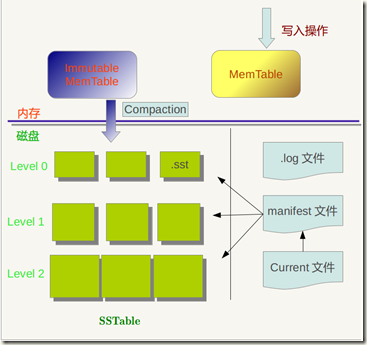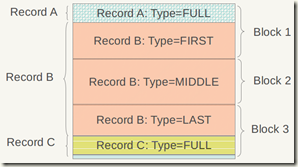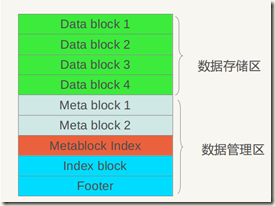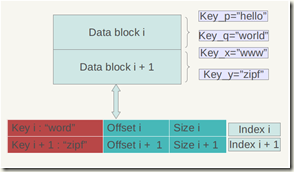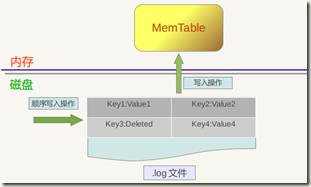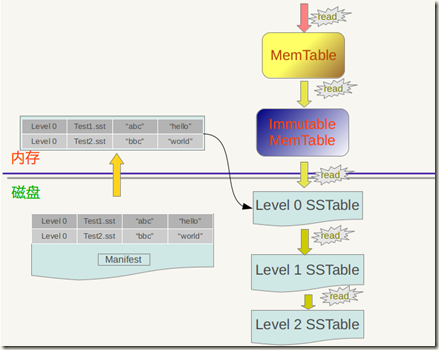详解SSTable结构和LSMTree索引
http://www.igvita.com/2012/02/06/sstable-and-log-structured-storage-leveldb/, SSTable and Log Structured Storage: LevelDB
The Sorted String Table (SSTable) is one of the most popular outputs for storing, processing, and exchanging datasets.
An SSTable is a simple abstraction to efficiently store large numbers of key-value pairs while optimizing for high throughput, sequential read/write workloads.
Unfortunately, the SSTable name itself has also been overloaded by the industry to refer to services that go well beyond just the sorted table, which has only added unnecessary confusion to what is a very simple and a useful data structure on its own. Let's take a closer look under the hood of an SSTable and how LevelDB makes use of it.
SSTable: Sorted String Table
SSTable本身是个简单而有用的数据结构, 而往往由于工业界对于它的overload, 导致大家的误解
它本身就像他的名字一样, 就是a set of sorted key-value pairs
如下图左, 当文件比较大的时候, 也可以建立key:offset的index, 用于快速分段定位, 但这个是可选的.
这个结构和普通的key-value pairs的区别, 可以support range query和random r/w
A "Sorted String Table" then is exactly what it sounds like, it is a file which contains a set of arbitrary, sorted key-value pairs inside.
Duplicate keys are fine, there is no need for "padding" for keys or values, and keys and values are arbitrary blobs. Read in the entire file sequentially and you have a sorted index. Optionally, if the file is very large, we can also prepend, or create a standalone key:offset index for fast access.
That's all an SSTable is: very simple, but also a very useful way to exchange large, sorted data segments.
SSTables and Log Structured Merge Trees
仅仅SSTable数据结构本身仍然无法support高效的range query和random r/w的场景
还需要一整套的机制来完成从memory sort, flush to disk, compaction以及快速读取……这样的一个完成的机制和架构称为,"The Log-Structured Merge-Tree" (LSM Tree)
名字很形象, 首先是基于log的, 不断产生SSTable结构的log文件, 并且是需要不断merge以提高效率的
下图很好的描绘了LSM Tree的结构和大部分操作
![image_thumb[3][1] image_thumb[3][1]](http://images0.cnblogs.com/blog/312753/201304/16145933-76ad5aabbe6b4cd5a2e72af0df739e18.png)
We want to preserve the fast read access which SSTables give us, but we also want to support fast random writes. Turns out, we already have all the necessary pieces: random writes are fast when the SSTable is in memory (let's call it MemTable), and if the table is immutable then an on-disk SSTable is also fast to read from. Now let's introduce the following conventions:
- On-disk
SSTableindexes are always loaded into memory - All writes go directly to the
MemTableindex - Reads check the MemTable first and then the SSTable indexes
- Periodically, the MemTable is flushed to disk as an SSTable
- Periodically, on-disk SSTables are "collapsed together"
What have we done here? Writes are always done in memory and hence are always fast. Once the MemTable reaches a certain size, it is flushed to disk as an immutable SSTable. However, we will maintain all the SSTable indexes in memory, which means that for any read we can check the MemTable first, and then walk the sequence of SSTable indexes to find our data. Turns out, we have just reinvented the "The Log-Structured Merge-Tree" (LSM Tree), described by Patrick O'Neil, and this is also the very mechanism behind "BigTable Tablets".
LSM & SSTables: Updates, Deletes and Maintenance
This "LSM" architecture provides a number of interesting behaviors: writes are always fast regardless of the size of dataset (append-only), and random reads are either served from memory or require a quick disk seek. However, what about updates and deletes?
Once the SSTable is on disk, it is immutable, hence updates and deletes can't touch the data.
Instead, a more recent value is simply stored in MemTable in case of update, and a "tombstone" record (不能直接删除,标上已deleted) is appended for deletes.
Because we check the indexes in sequence, future reads will find the updated or the tombstone record without ever reaching the older values!
Finally, having hundreds of on-disk SSTables is also not a great idea, hence periodically we will run a process to merge the on-disk SSTables, at which time the update and delete records will overwrite and remove the older data.
SSTables and LevelDB
Take an SSTable, add a MemTable and apply a set of processing conventions and what you get is a nice database engine for certain type of workloads.
In fact, Google's BigTable, Hadoop's HBase, and Cassandra amongst others are all using a variant or a direct copy of this very architecture.
Simple on the surface, but as usual, implementation details matter a great deal. Thankfully, Jeff Dean and Sanjay Ghemawat, the original contributors to the SSTable and BigTable infrastructure at Google released LevelDB earlier last year, which is more or less an exact replica of the architecture we've described above:
- SSTable under the hood, MemTable for writes
- Keys and values are arbitrary byte arrays
- Support for Put, Get, Delete operations
- Forward and backward iteration over data
- Built-in Snappy compression
LevelDB中LSM Tree的实现细节
http://blog.csdn.net/anderscloud/article/details/7182165, LevelDB设计与实现
整体架构
由于LevelDB是开源的, 所以从中可以了解到更多的SSTable和LSM tree的实现细节
LevelDb作为存储系统,其中核心就是SSTable, 下面先看看SSTable在LevelDb中的结构是怎样的...
内存
Memtable, Immutable Memtable
写入首先写入Memtable, 当Memtable插入的数据占用内存到了一个界限后,需要将内存的记录导出到外存文件中.
生成新的Log文件和Memtable,原先的Memtable就成为Immutable Memtable,顾名思义,就是说这个Memtable的内容是不可更改的,只能读不能写入或者删除。新到来的数据被记入新的Log文件和Memtable,LevelDb后台调度会将Immutable Memtable的数据导出到磁盘,形成一个新的SSTable文件.
磁盘
主要是多level的SSTable(levelDB也由此得名), 每个SSTable文件, 以.sst为后缀, 并且文件内的key:value都是按key排序的, 局部有序
Level 0 SSTable, 由Immutable Memtable进行minor compaction得到. 所以level 0比较特殊, SSTable files之间的key range会有重合, 因为是从Memtable compaction生成, 所以无法保证不重合
其他level SSTable, 由上级的SSTable进行major compaction得到, 比如level 1是由level 0 compaction得到
不断把多个低级别的SSTable, compaction到一个高级别的SSTable, 目的是提高读效率, 因为如果需要打开很多的SSTable进行查询, 明显效率会很低. 而经过多level的compaction, 来删除掉一些不再有效的KV数据, 减小数据规模, 减少文件数量等, 使效率大大提高.
Bigtable中讲到三种类型的compaction: minor, major和full。所谓minor Compaction,就是把memtable中的数据导出到SSTable文件中;major compaction就是合并不同层级的SSTable文件,而full compaction就是将所有SSTable进行合并。LevelDb包含其中两种,minor和major。
除了SSTable文件外, 还有3种files,
log文件, 防止数据丢失的
当应用写入一条Key:Value记录的时候,LevelDb会先往log文件里写入,成功后将记录插进Memtable中,这样基本就算完成了写入操作,因为一次写入操作只涉及一次磁盘顺序写和一次内存写入,所以这是为何说LevelDb写入速度极快的主要原因。
Manifest文件,记录各个SSTable文件的元数据, 哪一层,范围
Current文件, 记录当前的manifest文件名
因为在LevleDb的运行过程中,随着Compaction的进行,SSTable文件会发生变化,会有新的文件产生,老的文件被废弃,Manifest也会跟着反映这种变化,此时往往会新生成Manifest文件来记载这种变化,而Current则用来指出哪个Manifest文件才是我们关心的那个Manifest文件。
log文件结构
LevelDb对于一个log文件,会把它切割成以32K为单位的物理Block,每次读取的单位以一个Block作为基本读取单位. 为什么要分block? 应该出于磁盘读取效率的考虑
记录如果在一个block里面就可以放下, 那么Type就是full, 如A, C
记录如果需要多个block才可以放下, 那么Type分别是, First, Middle, Last 如B
至于每条record的逻辑结构如下,
SSTable文件结构
SSTable, .sst文件的结构, 也是分成固定大小的block.
除了大部分Data blocks外, 在文件的末端, 还会有一些用于数据管理的blocks…
其中比较重要的是, block index, 这个用于有效的提高读效率, 尤其当SSTable比较大的时候
索引的结构如下图, 也很简单
其他细节,参考原文
MemTable详解
LevelDb的MemTable提供了将KV数据写入,删除以及读取KV记录的操作接口,但是事实上Memtable并不存在真正的删除操作,删除某个Key的Value在Memtable内是作为插入一条记录实施的,但是会打上一个Key的删除标记,真正的删除操作是Lazy的,会在以后的Compaction过程中去掉这个KV。
需要注意的是,LevelDb的Memtable中KV对是根据Key大小有序存储的,在系统插入新的KV时,LevelDb要把这个KV插到合适的位置上以保持这种Key有序性。其实,LevelDb的Memtable类只是一个接口类,真正的操作是通过背后的SkipList来做的,包括插入操作和读取操作等,所以Memtable的核心数据结构是一个SkipList。
SkipList是由William Pugh发明。他在Communications of the ACM June 1990, 33(6) 668-676 发表了Skip lists: a probabilistic alternative to balanced trees,在该论文中详细解释了SkipList的数据结构和插入删除操作。SkipList是平衡树的一种替代数据结构,但是和红黑树不相同的是,SkipList对于树的平衡的实现是基于一种随机化的算法的,这样也就是说SkipList的插入和删除的工作是比较高效的.
关于SkipList的详细介绍可以参考这篇文章:http://www.cnblogs.com/xuqiang/archive/2011/05/22/2053516.html,LevelDb的SkipList基本上是一个具体实现,并无特殊之处
SkipList不仅是维护有序数据的一个简单实现,而且相比较平衡树来说,在插入数据的时候可以避免频繁的树节点调整操作,所以写入效率是很高的,LevelDb整体而言是个高写入系统,SkipList在其中应该也起到了很重要的作用。Redis为了加快插入操作,也使用了SkipList来作为内部实现数据结构。
SSTable读写操作
写入操作
对于SSTable而言, 插入, 更新, 删除, 都是通过append来实现的, 只不过delete插入的“Key:删除标记”, 后台Compaction的时候才去做真正的删除操作, 如key3
读操作
SSTable的读操作比较复杂一些, 不过下图还是比较好的反映出读取的过程,
MemTable –> Immutable MemTable –> Level0 SSTable –> Level1 SSTable –> Leveln
这个顺序是有很道理的, 由于SSTable所有的写都是append, 所以同一个key的value可能有很多版本, 而我们只关心最新的那个
所以我们只要安装这个顺序区读, 就能保证读到最新的那个版本
对于Level0 SSTable稍微特殊些, 因为对于这个级别SSTable files之间key会有重复的, 所以读的时候, 先找出level 0中哪些文件包含这个key, 并取最新的
怎样从.sst文件里面读到数据?
levelDb一般会先在内存中的Cache中查找是否包含这个文件的缓存记录,如果包含,则从缓存中读取;如果不包含,则打开SSTable文件,同时将这个文件的索引部分加载到内存中并放入Cache中。 这样Cache里面就有了这个SSTable的缓存项,但是只有索引部分在内存中,之后levelDb根据索引可以定位到哪个内容Block会包含这条key,从文件中读出这个Block的内容,在根据记录一一比较,如果找到则返回结果,如果没有找到,那么说明这个level的SSTable文件并不包含这个key,所以到下一级别的SSTable中去查找
可以看出对于SSTable, 相对写操作,读操作处理起来要复杂很多,所以写的速度必然要远远高于读数据的速度,也就是说,LevelDb比较适合写操作多于读操作的应用场合。而如果应用是很多读操作类型的,那么顺序读取效率会比较高,因为这样大部分内容都会在缓存中找到,尽可能避免大量的随机读取操作。
顺序读, 加载一个SSTable到内存, 可以读很多kv, 因为kv在sst文件中就是按顺序存放的, 如果随机读, 效率就比较低, 因为cache的命中率很低, 需要频繁的open不同的sst文件.



